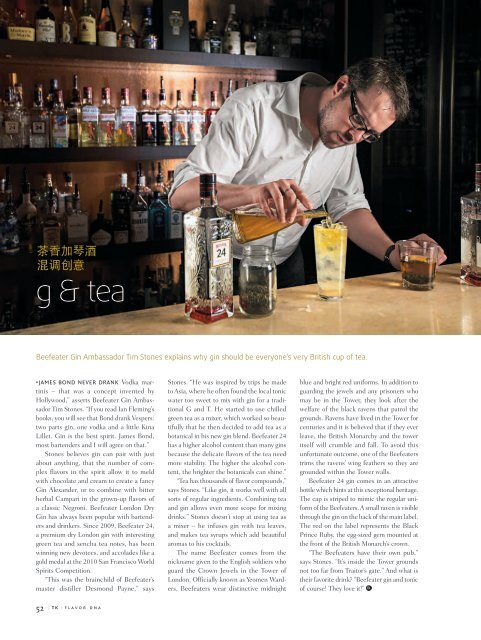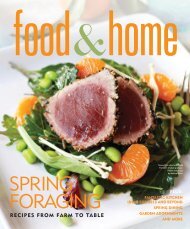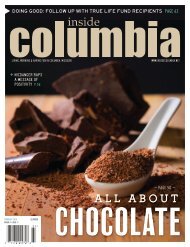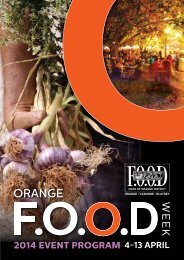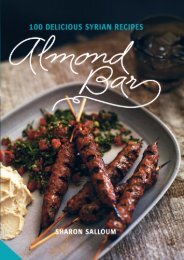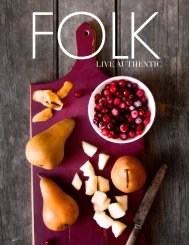Tasting Kitchen
Welcome to Tasting Kitchen. Season’s Greetings – or should I say Seasonings Greetings! This holiday TK issue is full of spices and flavorings. We talk to four talented and ambitious chefs about the flavor profile – or Flavor DNA – of dishes from India, Sichuan, Vietnam and the Isaan region of Thailand. Think cardamom, black salt and saffron, red peppercorns, red chilies and green chilies, dill, Kaffir lime, lemongrass, coriander, galangal and turmeric. We take a look at spices in history, and how even back in the Middle Ages savvy marketers knew the value of a good story. Spice merchants claimed that birds used cinnamon sticks to make giant nests in the cliffs above beaches in India, which “cinnamon hunters” then plotted to obtain. Today India is still associated with the world’s best spices. In this issue, for our first Tasting Destinations feature, TK’s Director of Photography David Hartung and Senior Writer Lucy Morgan traveled to Old Delhi to visit the world’s largest spice market and to New Delhi to visit one of the world’s top restaurants for modern Indian cuisine. One of our featured wines is the peppery Austrian Grüner Veltliner. We also talk to a New Zealand Wine Master about what makes great wine great, and to a leading French Champagne Chef de Cave about the value of patience and restraint. There are also some crabs running loose in the issue. A master chef in Macau shares his recipe for Quinoa Lobster Salad while five more from Hong Kong and Singapore share their favorite crab dishes and culinary musings. Happy Holidays,
Welcome to Tasting Kitchen.
Season’s Greetings – or should I say
Seasonings Greetings!
This holiday TK issue is full of spices and
flavorings.
We talk to four talented and ambitious
chefs about the flavor profile – or Flavor DNA
– of dishes from India, Sichuan, Vietnam and
the Isaan region of Thailand. Think cardamom,
black salt and saffron, red peppercorns, red
chilies and green chilies, dill, Kaffir lime,
lemongrass, coriander, galangal and turmeric.
We take a look at spices in history, and
how even back in the Middle Ages savvy marketers knew the value of a good story.
Spice merchants claimed that birds used cinnamon sticks to make giant nests in the
cliffs above beaches in India, which “cinnamon hunters” then plotted to obtain.
Today India is still associated with the world’s best spices. In this issue, for
our first Tasting Destinations feature, TK’s Director of Photography David Hartung
and Senior Writer Lucy Morgan traveled to Old Delhi to visit the world’s largest
spice market and to New Delhi to visit one of the world’s top restaurants for modern
Indian cuisine.
One of our featured wines is the peppery Austrian Grüner Veltliner. We also
talk to a New Zealand Wine Master about what makes great wine great, and to a
leading French Champagne Chef de Cave about the value of patience and restraint.
There are also some crabs running loose in the issue. A master chef in Macau
shares his recipe for Quinoa Lobster Salad while five more from Hong Kong and
Singapore share their favorite crab dishes and culinary musings.
Happy Holidays,
Create successful ePaper yourself
Turn your PDF publications into a flip-book with our unique Google optimized e-Paper software.
FEATURE<br />
茶 香 加 琴 酒<br />
混 调 创 意<br />
g & tea<br />
Beefeater Gin Ambassador Tim Stones explains why gin should be everyone’s very British cup of tea.<br />
“JAMES BOND NEVER DRANK Vodka martinis<br />
– that was a concept invented by<br />
Hollywood,” asserts Beefeater Gin Ambassador<br />
Tim Stones. “If you read Ian Fleming’s<br />
books, you will see that Bond drank Vespers:<br />
two parts gin, one vodka and a little Kina<br />
Lillet. Gin is the best spirit. James Bond,<br />
most bartenders and I will agree on that.”<br />
Stones believes gin can pair with just<br />
about anything, that the number of complex<br />
flavors in the spirit allow it to meld<br />
with chocolate and cream to create a fancy<br />
Gin Alexander, or to combine with bitter<br />
herbal Campari in the grown-up flavors of<br />
a classic Negroni. Beefeater London Dry<br />
Gin has always been popular with bartenders<br />
and drinkers. Since 2009, Beefeater 24,<br />
a premium dry London gin with interesting<br />
green tea and sencha tea notes, has been<br />
winning new devotees, and accolades like a<br />
gold medal at the 2010 San Francisco World<br />
Spirits Competition.<br />
“This was the brainchild of Beef eater’s<br />
master distiller Desmond Payn e,” says<br />
Stones. “He was inspired by trips he made<br />
to Asia, where he often found the local tonic<br />
water too sweet to mix with gin for a traditional<br />
G and T. He started to use chilled<br />
green tea as a mixer, which worked so beautifully<br />
that he then decided to add tea as a<br />
botanical in his new gin blend. Beefeater 24<br />
has a higher alcohol content than many gins<br />
because the delicate flavors of the tea need<br />
more stability. The higher the alcohol content,<br />
the brighter the botanicals can shine.”<br />
“Tea has thousands of flavor compounds,”<br />
says Stones. “Like gin, it works well with all<br />
sorts of regular ingredients. Combining tea<br />
and gin allows even more scope for mixing<br />
drinks.” Stones doesn’t stop at using tea as<br />
a mixer – he infuses gin with tea leaves,<br />
and makes tea syrups which add beautiful<br />
aromas to his cocktails.<br />
The name Beefeater comes from the<br />
nickname given to the English soldiers who<br />
guard the Crown Jewels in the Tower of<br />
London. Officially known as Yeomen Warders,<br />
Beefeaters wear distinctive midnight<br />
blue and bright red uniforms. In addition to<br />
guarding the jewels and any prisoners who<br />
may be in the Tower, they look after the<br />
welfare of the black ravens that patrol the<br />
grounds. Ravens have lived in the Tower for<br />
centuries and it is believed that if they ever<br />
leave, the British Monarchy and the tower<br />
itself will crumble and fall. To avoid this<br />
unfortunate outcome, one of the Beefeaters<br />
trims the ravens’ wing feathers so they are<br />
grounded within the Tower walls.<br />
Beefeater 24 gin comes in an attractive<br />
bottle which hints at this exceptional heritage.<br />
The cap is striped to mimic the regular uniform<br />
of the Beefeaters. A small raven is visible<br />
through the gin on the back of the main label.<br />
The red on the label represents the Black<br />
Prince Ruby, the egg-sized gem mounted at<br />
the front of the British Monarch’s crown.<br />
“The Beefeaters have their own pub,”<br />
says Stones. “It’s inside the Tower grounds<br />
not too far from Traitor’s gate.” And what is<br />
their favorite drink? “Beefeater gin and tonic<br />
of course! They love it!”<br />
52<br />
| TK | flavor dna


